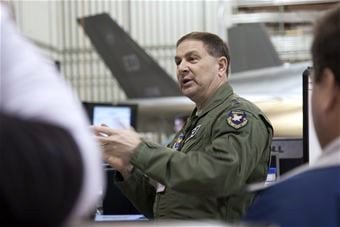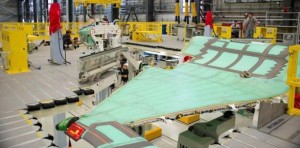
Lt. Gen. Christopher Bogdan
NATIONAL PRESS CLUB: The good news for the Pentagon’s largest program is that the difficult early days are almost over. The bad news: now it’s time for the next hard part.
“We are beyond slow and steady progress on the F-35 program now. We are into the phase of rapidly accelerating and growing,” said Lt. Gen. Chris Bogdan, program executive officer (PEO) for the F-35. After two decades of often-troubled development of ambitious technology, the F-35 will complete its roughly $50 billion development phase in 2017. Now the challenge is to build the stealth fighter in bulk and sustain the global fleet — a different but by no means easy problem.
“We’re going to triple the production ramp and the fielding rate on this airplane in just three years,” said Bogdan, from 40-odd new planes a year to over 120. “That gives me some pause.”
“What I most worry about and what we most have to concentrate on is the supply base,” Bogdan said. As production accelerates, suppliers must build more components for new planes — but as the fleet in service grows, the same suppliers must also build more components for spare parts. Both demands will increase at once: The more new planes produced in any given year, the more planes there’ll be in service to supply, maintain, and repair in every year that follows.
The greatest near-term challenge: Every F-35 built so far — in fact, every F-35 that will be built for a few years to come — will require some kind of modification to achieve full capability. The key component is the 3F iteration of the software package, but many aircraft will require labor-intensive physical alterations as well.
Today there are 126 F-35s of various models in service (plus 19 test aircraft); by the end of 2019, that will skyrocket to 493. “When we have those 493 airplanes out in the field in 2019, guess how many of them will be in what I consider to be the right configuration?” Bogdan asked the ComDef conference here. “Not. A. One. Every one of the airplanes coming off the production line today and coming off the production line for the next two and a half years, plus all the airplanes we’ve built already, will need some form of modification to get them up to the full capability that we promised the warfighter. That is a massive undertaking..”
The price is not just dollars but time: Taking an aircraft out of service for modifications means pilots can’t use it to train. That’s a major concern when you have to train a whole new fleet of pilots, Bodgan acknowledged, especially to meet the Air Force’s planned Initial Operational Capability (IOC) date for its F-35A model.
The key will be keeping modification work quick and throughput of airplanes high, said Bogdan. One measure the program is taking is sending “field teams” to overhaul F-35s at their bases, rather than bringing the planes back to central depots as is usual for such work. The F-35 depot capacity is nascent anyway, he said.
Modifications aren’t the only issue, however. The ALIS logistics system continues to operate far short of its potential, Bogdan said, while the five software reprogramming labs required to keep the aircraft updated just aren’t standing up fast enough.
Nevertheless, Bogdan showed every sign of confidence that the F-35 was jetting out of the woods. While the program will never be problem-free, he said, “we’re seeing problems long in advance, we’re mitigating risk long in advance, [so] where we don’t get surprised as much as we used to.”
Things should keep on getting more predictable, he went on. “When we get to LRIP 11 [Low-Rate Initial Production lot 11], we will be done with all the hardware changes and the production cut-ins for the full 3F capability,” he said. “At the start of lot 12 that we have a stable hardware and software configuration for the airplane” — which means a major reduction in risk and cost.
Production costs are already coming down by 3-4 percent from one lot to the next, Bogdan said, so on current trends, “by 2019, in fiscal year 2019 dollars, we’re going to sell an A-model for somewhere between 80 and 85 million. That’s not so bad… for the capability that you get.”
Airbus, UK agree $152 million deal for 6 H145 ‘overseas’ helicopters
The fleet of light-twin rotorcraft will replace Airbus Puma HC2 types, which have been temporarily based in Brunei for British Army training and the island of Cyprus in support of Royal Air Force search and rescue missions.


























